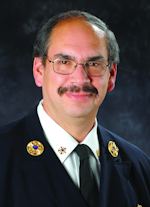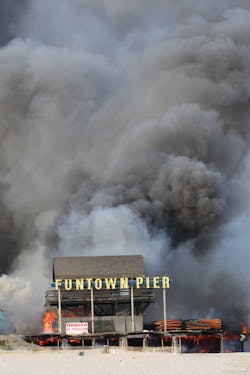Editor’s Note: The Firehouse staff wanted to share some of long-time Editor in Chief Harvey Eisner’s work. Harvey, a fixture on New York City firegrounds and at major events and conferences since the 1970s, passed away on Oct. 23. He was 59. He has worked with Firehouse since its inception in 1976. He began serving with the Tenafly, N.J., Fire Department in 1975 and served as chief for 12 years.
A fire in Seaside Park, NJ, in September 2013 that originated under a section of boardwalk spread to four blocks of commercial buildings that housed more than 50 businesses. The wind-swept fire required the response of 50 of the 60 fire departments in Ocean County and task forces from neighboring counties. The area had been devastated last year during Hurricane Sandy and was in the process of being rebuilt, reopened and renovated when the fire occurred.
The Seaside Park Fire Department protects an area measuring 0.7 of a mile in Seaside Park, a half-mile in South Seaside Park and 11 miles of the Beach State Park along the Atlantic Ocean. Located in Ocean County, NJ, the community took the brunt of Hurricane Sandy, which hit the area head-on. The population ranges from 1,600 in the winter to 30,000 during the summer. The area is only four to five blocks at its widest point and is situated between the Atlantic Ocean and Barnegat Bay. A major fire destroyed the same area in 1955. The fire department averages 300 runs per year. Last year, firefighters responded to 300 additional calls related to Hurricane Sandy. It took two days to evacuate residents who stayed during the storm.
On Sept. 12 at 2:18 P.M., units were dispatched to a report of flames showing underneath the boardwalk in the area of the Sawmill Restaurant. The Sawmill is a local landmark that also housed a bar and a banquet hall. Units had responded to the area on a regular basis for alarms, working fires and minor incidents such as reports of a cigarette being dropped between the planks of the boardwalk and smoldering underneath. Access panels located in the area provided access to spaces below the boardwalk; a firefighter would be able to drop down and crouch while moving under the boardwalk. After Sandy pushed large amounts of beach sand into those areas, firefighters would have had to crawl on their stomachs to gain access.
A police detective and the Seaside Park assistant fire chief arrived at the scene at the same time. Heavy smoke was showing, but there was no visible fire. The first engine was on the scene within a few minutes. Access was made in to a world-famous, one-story ice cream store. There was a smoke condition, but no heat. Buildings on either side of the boardwalk where the fire started were eight to 10 feet apart. In some areas this section of the boardwalk, built in the 1950s, is well constructed and strong enough for vehicles to make deliveries, but not fire apparatus.
The awnings of adjacent buildings are so close to one another that they almost touch. The rest of the original fire area is adjacent to Funtown Pier, an area that was heavily damaged during Sandy, when a portion of the pier was destroyed and swept out into the ocean. The area contains buildings in a congested, maze-like area. Many of the basements are interconnected.
The first engine started to stretch handlines as the second crew used power saws and pry bars to attempt to open the boardwalk. The assistant fire chief from adjacent Seaside Heights was on that community’s section of the boardwalk and walked down to the scene. A second alarm was called immediately. The fire started at the north end of Seaside Park and extended to the southern end of Seaside Heights. A supply line was stretched to augment the first engine and additional line into the sprinkler siamese for the Sawmill restaurant.
Winds were coming out of the south and heading directly up the boardwalk at 25 to 30 mph. Additional companies forced entry to locked gates to gain access to the pier to the east.
Seaside Park Fire Chief David Hansen arrived and took command. Some of the incoming units that had been directed to cover nearby stations were redirected directly to the fire. Additional water sources were being used to supply ladder pipes, deck guns and numerous handlines. Some master streams were set up on the west side of the fire as it continued to spread north, fanned by the high winds. The tremendous smoke conditions and large burning embers pushed northward toward additional exposures. At one point an evacuation order was given to all firefighters operating on the eastside of the fire. It was simply too dangerous to operate in those areas. The fire was not only extending from building to building but also underneath the boardwalk continually fanned by the constant wind.
Dispatchers notified the incident commander that several fire alarms were being received from commercial occupancies north of the visible fire. In one location, a building was on fire, but additional fire was far past that spot underneath the boardwalk. Additional companies were directed to get ahead of the fire as winds continued to drive the fire directly north in line with the boardwalk.
Water mains along the oceanfront were eight inches wide. There were six inch mains nearby and in Seaside Heights a 12-inch main supplied that area. The water company was notified to do what it could to increase pressure and open interconnects between the different water companies.
Burning embers were being blown several blocks ahead of the fire and firefighters were being pelted with large chunks of burning tar and wood. The immediate original fire area contained only commercial buildings, but fire communicated to the roof of an occupied condominium to the north. This fire became serious and other responding units were directed to this and other locations. The police evacuated blocks in the path of the fire that included several occupied dwellings. Additional units, including brush trucks and mini-pumpers, were used to chase burning embers. Fires also communicated to the roofs of restaurants and to the boardwalk seven blocks to the north.
At the height of the fire, 50 of the 60 fire departments from Ocean County responded to the scene. Task forces were requested from four neighboring counties. Some of these units responded to the scene or to cover empty firehouses. A task force from one county responded with additional engines as a five-inch hose pipeline to augment water supply. An additional 4,000 to 5,000 feet of large-diameter hose was stretched to Barnegat Bay and another five-inch supply line was stretched about 4,000 feet to the bay as a backup.
A track-hoe was used to make a trench cut in the boardwalk to create a fire break. Additional handlines, deck guns and ladder pipes were positioned to try to make a stop. The piece of construction equipment was extremely useful in making the trench cut. It was straining to remove the lumber from this section of the boardwalk as it had just recently been reconstructed for the summer season after Sandy. The fire was eventually controlled at this trench cut. The use of an aggressive defensive attack is credited with stopping the inferno. The fire spread north, consuming four total blocks measuring about 900 feet, including more than 40 businesses.
One of the regional coordinators suggested using additional large-diameter hose systems. Eventually, the Neptune System from northern New Jersey was requested. Units responded and stretched a three-quarter-mile, 12-inch water line and drafted from the bay. The system pumped 6,500 gpm for about six hours. Approximately 2.3 million gallons of water were transported using this system. This water was used in the overhaul stage. Throughout the fire, numerous law enforcement agencies responded with food and refreshments. Neighbors and businesses also came to help.
Units remained on scene until about 5 P.M. the following day. Crews from several task forces were used to cover empty fire stations. There were no firefighter injuries. A wide variety of fire equipment was lost, especially when firefighters were ordered to immediately evacuate dangerous areas.
Last year, the Seaside Park Fire Department had to deal with Hurricane Sandy. This year, the department was first-due to the boardwalk inferno. In between, members celebrated their 100th anniversary on May 6, 2013.
More Coverage On Firehouse App
You can find more photos and information about the New Jersey boardwalk fire by downloading the Firehouse Limited Tablet edition on Nov. 15. Search “Firehouse Magazine” in iTunes or Google play and download the exclusive content for your iPad, Samsung Galaxy Tab, Motorola Zoom and Nexus Android devices.

Harvey Eisner | Editor Emeritus
HARVEY EISNER was named Editor Emeritus of Firehouse® after serving 15 years as Firehouse's Editor-in-Chief. He joined the Tenafly, NJ, Fire Department in 1975 and served as chief of department for 12 years. He was a firefighter in the Stillwater, OK, Fire Department for three years while attending Oklahoma State University. Eisner was an honorary assistant chief of the FDNY and program director for the Firehouse Expo, Firehouse World and Firehouse Central conferences. He covered many major fires and disasters and interviewed numerous fire service leaders for Firehouse®






